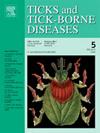肩胛骨伊蚊的分类交配,1821(蜱螨亚纲:伊蚊科)。
IF 3.4
2区 医学
Q2 INFECTIOUS DISEASES
引用次数: 0
摘要
配偶选择影响着自然种群的近亲繁殖水平和遗传多样性。例如,正分类交配(PAM)已经在蓖麻伊蚊(Ixodes ricinus L.)中被描述,但这种行为尚未在密切相关的肩胛骨伊蚊(Ixodes肩胛骨伊蚊,1821)中被调查。通过分析2010年秋季狩猎季节从萨凡纳河遗址(南卡罗来纳州)采集的30只雌鹿和30只雄鹿标本的9个微卫星位点,我们在种群中发现了一个微弱但重要的分类配对特征,否则,它们在遗传上是同质的。这表明,尽管同一配对的成员之间的平均相对亲缘关系较低,但观察到的与所有其他可能的雄性-雌性配对之间的差异非常显著。结果表明,我们的非编码微卫星位点是由PAM编码基因通过搭便车的方式起草的。为了解释我们的数据,这些基因需要均匀分布在基因组中,并且从少数对PAM有主要影响的基因到许多对PAM有中等或弱影响的基因。本文章由计算机程序翻译,如有差异,请以英文原文为准。
Assortative mating in Ixodes scapularis Say, 1821 (Acari: Ixodidae)
Mate choice influences levels of inbreeding and genetic diversity in natural populations. Positive assortative mating (PAM), for instance, has been described in Ixodes ricinus L., but this behavior has yet to be investigated in the closely related Ixodes scapularis Say, 1821. By analyzing nine microsatellite loci of 30 females and 30 males removed in copula from hunter-harvested deer specimens at the Savannah River Site (South Carolina) during the hunting season of fall 2010, we found a weak but significant assortative pairing signature in a population that, otherwise, appeared genetically homogeneous. This indicated that in spite of a low average relative relatedness between members of the same pair, the difference between observed and all other possible male-female pairs was highly significant. The results suggested that our non-coding microsatellite loci were drafted by genes coding for PAM, through genetic hitchhiking. To explain our data, such genes would need to be homogeneously distributed in the genome and span from a few genes with major effects on PAM to many genes with moderate or weak effects on PAM.
求助全文
通过发布文献求助,成功后即可免费获取论文全文。
去求助
来源期刊

Ticks and Tick-borne Diseases
INFECTIOUS DISEASES-MICROBIOLOGY
CiteScore
6.90
自引率
12.50%
发文量
185
审稿时长
6-12 weeks
期刊介绍:
Ticks and Tick-borne Diseases is an international, peer-reviewed scientific journal. It publishes original research papers, short communications, state-of-the-art mini-reviews, letters to the editor, clinical-case studies, announcements of pertinent international meetings, and editorials.
The journal covers a broad spectrum and brings together various disciplines, for example, zoology, microbiology, molecular biology, genetics, mathematical modelling, veterinary and human medicine. Multidisciplinary approaches and the use of conventional and novel methods/methodologies (in the field and in the laboratory) are crucial for deeper understanding of the natural processes and human behaviour/activities that result in human or animal diseases and in economic effects of ticks and tick-borne pathogens. Such understanding is essential for management of tick populations and tick-borne diseases in an effective and environmentally acceptable manner.
 求助内容:
求助内容: 应助结果提醒方式:
应助结果提醒方式:


